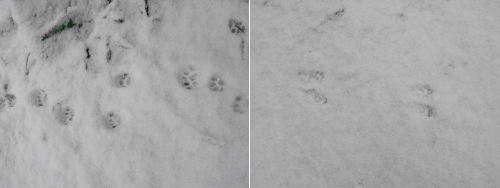
Farm Tracking 101, Part 1
With all of the snow
we've been getting this winter, I thought now might be a good time to
talk about one of my favorite snowy activities --- tracking. I've
decided to call this lunchtime series "Farm Tracking 101" because I'll
cover all of the basics you need to tell your chicken tracks from your
dog tracks and to figure out who's been nosing around your chicken
coop. I'll mention my favorite books and tools later, but for
now, let's dive right in!
Take a look at the two photos below. Yup, I've intentionally made
them too small to tease apart the shape of individual tracks. But
you can probably tell they're made by two different animals, right?

The animal on the left is a walker (a house cat in this case) ---
notice how its tracks aren't grouped into sets, but continue in a
staggered line from right to left. The animal on the right is a
bounder (probably a squirrel) which travels in leaps, leaving pairs (or
often sets of four) tracks with long spaces between them. If you
think about the animals you see around you, you'll probably be able to
guess which ones are walkers and which are bounders. Cats, dogs,
chickens, and deer are walkers. Mice, squirrels, chipmunks, and
rabbits are bounders.

Domesticated walkers often leave "muddied" track patterns like the
first photo of cat tracks, but wild walkers are more careful. The
track pattern above (a Red Fox) is typical of a wild walker which
carefully puts each hind foot into the same spot it put its fore
foot. The result is a very clear track pattern, and for the
animal a very quiet walk. By putting its hind feet in the same
spot it already put its fore feet, the fox is sure that it's not
stepping on a noisy leaf.
| This post is part of our Farm Tracking 101 lunchtime series.
Read all of the entries: |
Want more in-depth information? Browse through our books.
Or explore more posts by date or by subject.
About us: Anna Hess and Mark Hamilton spent over a decade living self-sufficiently in the mountains of Virginia before moving north to start over from scratch in the foothills of Ohio. They've experimented with permaculture, no-till gardening, trailersteading, home-based microbusinesses and much more, writing about their adventures in both blogs and books.
Want to be notified when new comments are posted on this page? Click on the RSS button after you add a comment to subscribe to the comment feed, or simply check the box beside "email replies to me" while writing your comment.
